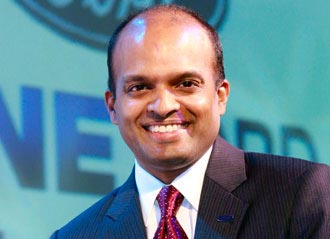Raj Nair will lead Ford in a three-way joint effort with Daimler and Renault-Nissan to launch the world’s first affordable, mass-market fuel-cell electric car (FCEV) as early as 2017.
“Working together will significantly help speed this technology to market at a more affordable cost to our customers,” said Nair, group vice president of global product development at Ford.
“We will all benefit from this relationship as the resulting solution will be better than any one company working alone.”
The partners hope that joining forces will help “define global specifications and component standards, an important prerequisite for achieving higher economies of scale,” according to a statement released by each of the three companies.
FCEVs offer the advantages of being completely emissions-free and promising about the same or slightly greater energy density than comparable gasoline engines. They are fueled by free atmospheric oxygen combining with stored hydrogen to produce electricity and water. The technology itself has been in use for over a half century, including in the Apollo and other manned space programs.
The hydrogen used in fuel-cell cars can be derived from a variety of sources, including natural gas, ethanol and even coal, offering a potential cost savings over gasoline refined from petroleum. The problem with that route would be to provide enough filling stations selling hydrogen. Also carrying hydrogen in a car poses some potential safety issues.
The alternative is to have FCEVs be fueled by gasoline or other diesel. But that would entail carrying an on-vehicle cracking plant to extract hydrogen from gasoline or diesel. Cracking hydrocarbons is a high-temperature process, posing formidable challenge of developing suitable materials and insulation.
Each automakers will invest an equal unspecified amount in their bid to “maximize design commonality, leverage volume and derive efficiencies through economies of scale” to enable a cost-effective FCEV by as early as 2017. Also, an alliance would be more effective in persuading industry or governments to invest the large sums needed to build hydrogen filling stations without fear of having their investments obsoleted by a superior EV technology.
“Fuel cell electric vehicles are the obvious next step to complement today’s battery electric vehicles as our industry embraces more sustainable transportation,” said Mitsuhiko Yamashita, member of the Nissan Board of Directors and executive vice president, supervising research and development.
The Ford-Daimler-Renault-Nissan alliance faces competition from the BMW-Toyota alliance which is also cooperating on fuel-cell technology as well as a potentially efficient battery for plug-in electric vehicles.
Raj Nair was named Ford Motor Company’s group vice president, Global Product Development effective April 1, 2012. Prior to that as Ford’s vice president of Engineering for Global Product Development, Nair oversaw all engineering for car, truck, SUV and crossover vehicles for the Ford and Lincoln brands.
That was preceded by two years as vice president, Operations, of Ford’s Asia Pacific and Africa region. Nair gained his management experience from various positions in manufacturing, product development and purchasing.
Nair joined Ford in 1987 as a body and assembly operations launch engineer and worked on 11 vehicle programs in 13 assembly plants, including vehicle operations launch manager for the 1996 European Fiesta. He later oversaw all of Ford Europe’s launches, including the Focus, Transit and Mondeo.
Nair received his BS in mechanical engineering with an automotive specialty from Kettering University in Flint, Michigan. He was the recipient of the 2007 Kettering Alumni Achievement Award in Engineering.


